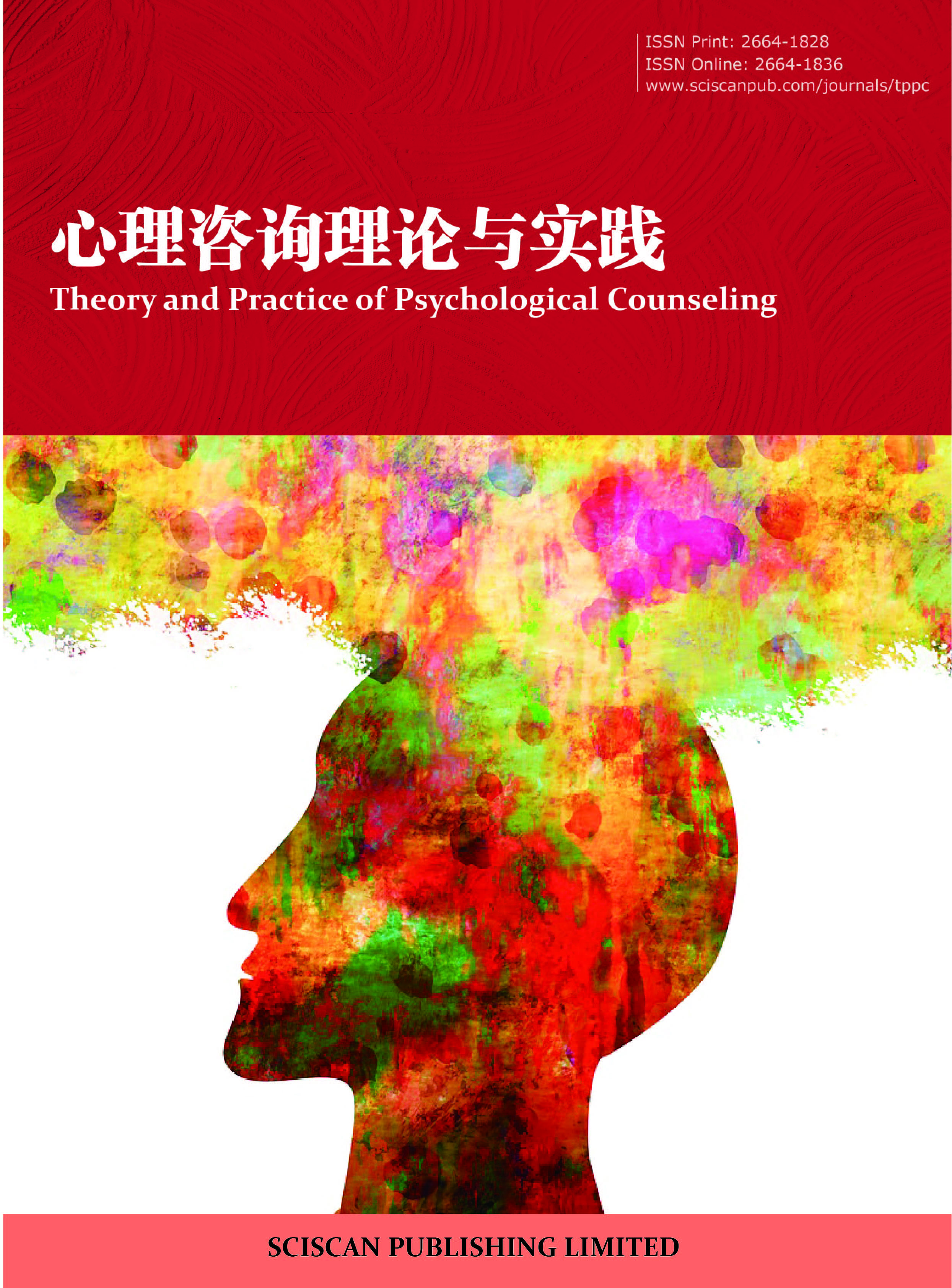Theory and Practice of Psychological Counseling
合理情绪疗法治疗原发性高血压伴焦虑的疗效观察
Effect of Rational-Emotion Therapy on Primary Hypertension With Anxiety
- Authors: 陈瑞芬 袁常艳 刘红茹 易晓庆 唐胜南 龚玲 周意
-
Information:
联保部队第921 医院,长沙
-
Keywords:
Reasonable-emotion therapy; Primary hypertension; Anxiety合理情绪疗法; 原发性高血压; 焦虑
- Abstract: Objective: To observe the effect of rational-emotion therapy in the treatment of primary hypertension with anxiety. Methods: 60 patients with primary hypertension with anxiety from 1 January 2018 to 31 December 2020 were randomly divided into observation and controls, with 30 each of the two groups. Routine care had been given to the control group, rational-emotion therapy had been carried to the observation group. Blood pressure, anxiety and nursing-satisfaction were compared before and after the intervention. Results: After treating, blood pressure in both groups decreased to different degrees, statistically significant, p<0.05; However, there was no significant differences between groups, p> 0.05;Compared with control groups, the observation groups showed higher nursing satisfaction, there was statistically significant differences in group-comparison, p<0.05. After psychological intervention, the two Hamiltonian anxiety scale(HAMA) scores decreased to varying degrees, and the contrasts were statistically significant, p<0.05. Conclusion: Rational-emotion therapy could treat primary hypertension with anxiety and , improved anxiety effectively, achieved better curative-effect. The blood-pressure of the observation group had been controled well than the control group, nursing-satisfaction had been improved also. That had certain clinical application value. 目的:观察合理情绪疗法治疗原发性高血压伴焦虑情绪的疗效。方法:选取于2018 年1 月1 日至2020 年12 月31 日在我院就医的原发性高血压伴焦虑患者60 例,随机分为观察组和对照组进行治疗,两组各30例。对照组予以常规护理,观察组在此基础上开展合理情绪疗法。比较两组干预前后患者血压、焦虑情绪及护理满意度情况。结果:治疗后,两组患者的血压均不同程度下降,差异有统计学意义,p<0.05;但组间比较差异无统计学意义,p>0.05;与对照组比较,观察组护理满意度更高,组间对比,差异有统计学意义,p<0.05。心理干预后,两组汉密顿焦虑量表(HAMA)评分不同程度下降,对比差异有统计学意义,p<0.05。结论:合理情绪疗法治疗原发性高血压伴焦虑患者,可取得较好的治疗疗效,可有效改善患者的焦虑情绪。观察组血压控制水平优于对照组,提升护理满意度,具有一定的临床应用价值。
- DOI: https://doi.org/10.35534/tppc.0309074
-
Cite:
陈瑞芬,袁常艳,刘红茹,等.合理情绪疗法治疗原发性高血压伴焦虑的疗效观察[J].心理咨询理论与实践,2021,3(9):601-605.
高血压是全球疾病谱最常见的慢性病,当前全球平均每4人即有1人患高血压,预计到2025年,将有超过15亿的高血压患者[1]。高血压可造成脑、心、肾等靶器官受损,通常患者会伴随焦虑等焦虑情绪,心理因素影响着高血压的预后、防治和转归,形成恶性循环,加重病情,心理干预广泛应用于慢性疾病的治疗[2]。本研究采用合理情绪疗法治疗原发性高血压伴焦虑患者,现报道如下。
1 资料与方法
1.1 一般资料
选取于2018年1月1日至2020年12月31日在我院就诊的原发性高血压伴焦虑患者60例,按照随机数字表法分为观察组及对照组,两组各30例。所有研究对象均符合《中国高血压防治指南》中的高血压诊断标准[3];所有患者均自愿参与本研究,签订了知情同意书。
纳入标准:(1)符合原发性高血压伴焦虑诊断标准;(2)既往无精神病史;(3)不伴随严重器质性障碍疾病;(4)认知正常;(5)入选前选择同一种降压药物治疗。
排除标准:(1)患有精神、意识障碍性疾病者;(2)有脑部手术史患者;(3)伴随严重器质性障碍疾病者;(4)纳入病例发生病情变化,或出现其他疾病者,或病情加重者,不能按规定治疗者。
其中观察组年龄为35—75岁之间,平均(49.2±1.4)岁,男18例,女12例,病程1—10年,平均(4.9±0.1)年;对照组年龄为32—74岁之间,平均(48.5±1.2)岁,男20例,女10例,病程1—11年,平均(4.8±0.3)年。两组患者基线资料的均衡性较高,具有可比性。
1.2 方法
1.2.1 对照组治疗方法
对照组应用常规护理,做好患者的药物治疗、生活护理、饮食干预,对患者的疑问积极解答。降压药选择苯磺酸氨氯地平片(国药准字H20020390,苏州东瑞制药公司)5 mg,每日一次,连续治疗8周。
1.2.2 观察组治疗方法
基于对照组的治疗基础,观察组加以合理情绪疗法ABCDE,具体操作如下:首先是心理分析阶段,每周干预2次,每次30分钟,干预2周。帮助患者觉察到不合理的信念(Believes),包括绝对化的、过分概括和糟糕至极的不合理信念(例如患高血压就一定导致中风偏瘫、拒绝接受患病事实、担心药物不良反应、自行减药或自行停药等)。其次是心理教育阶段,每周干预2次,每次30分钟,干预2周。帮助患者认识到不良情绪和行为表现带来的后果(Consequences),并寻找是哪些不合理信念产生这些情绪和行为。然后是心理修通阶段,每周干预2次,每次30分钟,干预2周。治疗者与患者反复进行交流和辩论(DisPuting);纠正患者对高血压的危险因素、生活方式、合理膳食、目标血压等事件(Activities)等扭曲的想法及观念。最后是心理领悟阶段,每周干预2次,每次30分钟,干预2周。患者逐步摆脱不合理信念,获得良好疗效(Effects)。观察组的降压药与对照组相同。
1.3 评价指标及标准
依据两组护理干预前后血压指标变化和汉密尔顿焦虑量表HAMA评分评估疗效。(1)无效:血压及临床症状无任何改善,甚至病情加重;(2)有效:血压降低≥10 mmHg,HAMA评分降低≥25%,临床症状有所改善;(3)显效:血压降低≥20 mmHg,HAMA评分降低≥50%,临床症状明显改善;(4)总有效率=(显效病例数+有效病例数)/总病例数。
发放护理满意度调查问卷,包括了健康教育、基础护理、责任心、服务态度等4个条目,每条目答题方式为0(不满意)-2分(非常满意)3个等级,分数越高,满意程度越高。
1.4 统计学处理
本研究应用统计学SPSS22.0软件对相关数据进行处理分析,计量资料用(x±s)表示,采用t检验比较,p<0.05则表示差异具有统计学意义。
2 结果
2.1 两组患者护理前后降压疗效比较
两组护理前血压各项指标比较差异无统计学意义,p>0.05。经护理后,两组患者血压均不同程度下降,对比治疗前差异有统计学意义,p<0.05;组间对比差异无统计学意义,p>0.05。见表1。
表 1 两组患者护理前后降压疗效比较(n,%)
Table 1 Comparison of antihypertensive efficacy before and after care of the two groups (n, %)
|
类别 |
例数 |
无效 |
有效 |
显效 |
有效率(%) |
|
观察组 |
30 |
2(6.67) |
15(50.00) |
13(43.33) |
28(93.33) |
|
对照组 |
30 |
9(30.00) |
14(46.66) |
7(13.33) |
21(70.00) |
2.2 两组患者护理前后HAMA评分比较
两组护理前HAMA评分比较差异无统计学意义,p>0.05。经护理后,两组患者HAMA评分均不同程度下降,对比治疗前差异有统计学意义,p<0.05;组间对比差异有统计学意义,p<0.05。见表2。
表 2 两组患者护理前后HAMA评分比较(x±s)
Table 2 Comparison of HAMA scores before and after care between the two patient groups (x±s)
|
姓名 |
例数 |
护理前 |
护理后 |
|
观察组 |
30 |
16.54±2.14 |
10.72±1.89 |
|
对照组 |
30 |
17.05±2.46 |
14.57±2.06 |
2.3 两组患者护理满意度比较
观察组的患者满意度为28例(93.33%),高对照组20例(66.67%),对比差异有统计学意义(p<0.05),见表3。
表 3 两组患者护理满意度比较(n,%)
Table 3 Comparison of Patient Care Satisfaction between the two patient groups (n, %)
|
姓名 |
例数 |
不满意 |
满意 |
非常满意 |
满意率 |
|
观察组 |
30 |
2(6.67) |
16(53.33) |
12(40.00) |
28(93.33) |
|
对照组 |
30 |
10(33.33) |
14(46.67) |
6(20.00) |
20(66.67) |
3 讨论
高血压是一种严重危害健康的慢性疾病,与情绪息息相关。当患者遭受不良情绪刺激后,会导致机体的交感神经变得格外兴奋,从而引发血管收缩,血压增高。
陈丽丽研究发现[4]高血压疾病初发时,患者常内心难以接受,并伴随不良心理,由于对疾病重视程度不够,加之自我管理能力较差,造成血压水平控制不达标。袁艳敏等研究发现[5]由于高血压病患者猝死率较高及预后状况不理想,故多数高血压病患者存在不安感与恐惧感,易出现焦虑等心理障碍。
门诊高血压病患者的心理特点主要为恐惧、焦虑、急躁不安,实施针对性护理措施可有效改善患者心理状态,有助于控制血压在理想状态[6]。吴量等研究表明[7]合理情绪疗法是护理程序中重要的组成部分,尊重患者、情志护理及诚挚体贴是提高护理质量的重要环节。合理情绪疗法是帮助患者解决因非理性观念产生情绪困扰的一种心理认知疗法,强调认知、行为和情绪三者之间的关联性[8]。陈美清[9]对原发性高血压患者增加合理情绪疗法干预,可以更加有效地对患者的血压水平进行控制,同时促使患者保持良好的心理状态,最大程度地降低原发性高血压给患者的生活质量造成的不利影响。
本研究发现,对高血压伴焦虑患者进行合理情绪疗法干预后,患者血压值与评分HAMA均有所降低。由于研究的局限性,接下来的研究拟增加样本量,进行长程随访。
综上所述,针对原发性高血压伴焦虑患者,采用合理情绪疗法治疗,有效改善患者的焦虑情绪,取得较好的降压疗效,并提升患者的生活质量,可为临床合理情绪疗法提供参考。
参考文献
[1] 张丹薇,张海波.高血压管理实践现状与进展[J].中华高血压杂志,2020(1):19-24.
[2] 李川川,张彦.对《国际高血压学会2020国际高血压实践指南》与我国高血压防治策略的思考[J].中华高血压杂志,2020,28(9):815-817.
[3] 中国高血压防治指南修订委员会.中国高血压防治指南2010[J].中华心血管病杂志,2011,39(7):579-616.
[4] 陈丽丽.合理情绪疗法对首发高血压患者的应用效果及负性情绪影响分析[J].中国冶金工业医学杂志,2021,38(1):35.
[5] 袁艳敏,郭华,兰冰,等.枸橼酸坦度螺酮联合常规降压治疗高血压病伴焦虑的疗效观察[J].中国医院用药评价与分析,2019,19(7):822-824.
[6] 韩艳蕊.门诊高血压病患者的心理特点及相应的护理措施分析[J].心理月刊,2021,16(2):93-94.
[7] 吴量,郭亚云,魏睦新.中西医合理情绪疗法的研究进展[J].中华现代护理杂志,2014,20(14):1748-1749.
[8] 白雪,蒋海,杨芬兰,等.合理情绪疗法对阴虚质高血压患者焦虑情绪影响的研究[J].贵阳中医学院学报,2018,40(3):59-62.
[9] 陈美清.合理情绪疗法干预对原发性高血压患者的护理效果分析[J].临床医药文献电子杂志,2020,7(77):85+89.
















